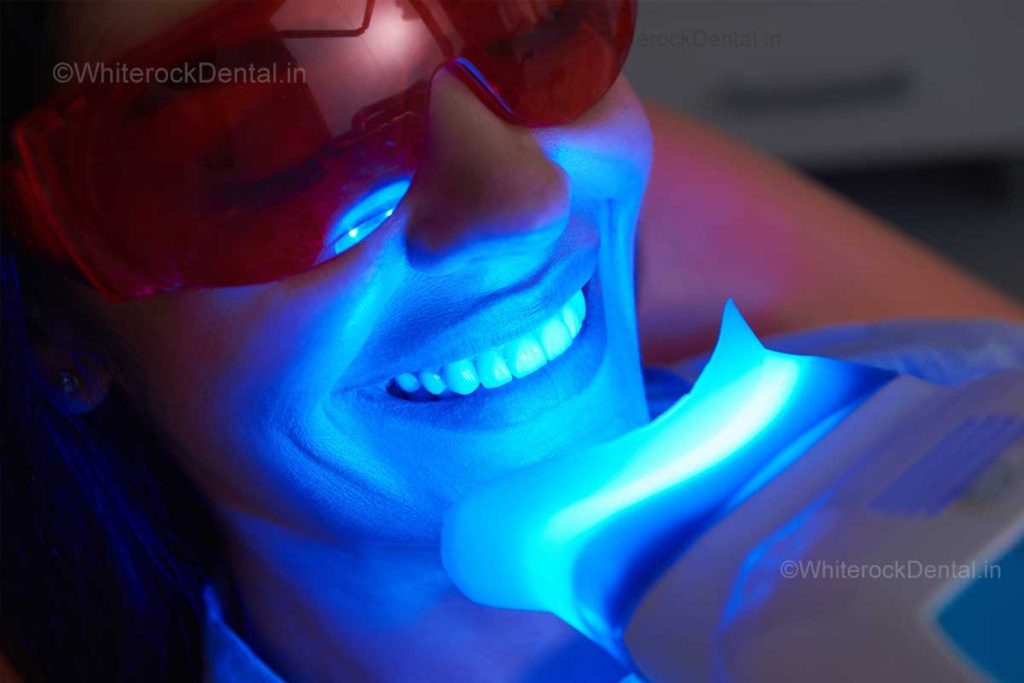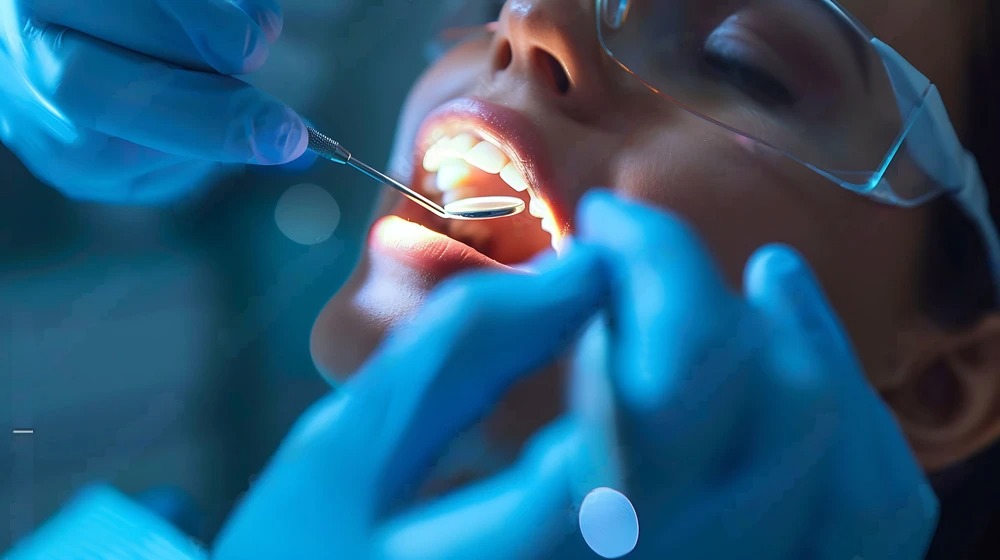
–By Dr Pauravi Hegde MDS, Endodontist Specializing in Crafting the Perfect Smile
Introduction: The Allure and the Concern
Laser whitening is the “it” procedure these days—your social media feeds might be packed with dramatic before-and-after shots of dingy teeth turning pure white in what seems like an instant. From Sion to Chembur, and Prabhadevi to Worli, more Mumbaikars are opting for this high-tech solution to look and feel more confident at weddings, job interviews, or just everyday life.
But along with the excitement comes a nagging question: Could laser whitening actually ruin your teeth? The internet is full of hype but not always the facts. As Dr Pauravi Hegde MDS, I’ve seen how misguided perceptions can either scare people away from a beneficial procedure or—worse—lead them into the hands of unskilled practitioners. So let’s cut through the rumors and get to the real deal.
In this article, we’ll tackle the potential risks of laser whitening—like enamel damage, gum irritation, and sensitivity—and how to avoid them. Because, yes, done wrong, laser whitening can cause harm. But done properly? It can safely take your smile from “meh” to movie-star radiant. Let’s dig in.
What Is Laser Whitening?
A Quick Recap
Laser whitening uses a specialized light or laser to accelerate the bleaching process on your teeth. Your dentist applies a potent bleaching gel—usually hydrogen peroxide or carbamide peroxide—and the laser’s wavelength helps break down stains quickly. It’s the “fast lane” of teeth whitening, offering:
- Quick results (sometimes in a single session).
- Deeper stain removal than some at-home kits.
- Professional oversight to ensure correct gel application and timing.
Common Benefits
- Speed: In a city like Mumbai, where time is money, a single 30–60 minute session is far easier than multiple weeks of at-home strips.
- Efficacy: Stronger bleaching agents and laser activation can yield more dramatic shade changes.
- Professional Approach: Under a dentist’s watchful eye, you minimize the risk of messing up your enamel with amateurish methods.
Why Concern About Risks?
So if it’s so great, why do we worry about it? Because:
- High-intensity gel plus laser heat can lead to enamel issues if poorly managed.
- Improper gum shielding might cause irritation or burns.
- Post-whitening sensitivity might be significant if you have underlying issues not addressed first.
Essentially, the same power that makes laser whitening so appealing also introduces potential pitfalls, especially in unqualified hands or for those who skip the necessary steps to protect their teeth and gums.
Potential Risk #1: Enamel Damage
How It Can Occur
Your enamel is your tooth’s armor—harder than bone, but not invincible. Laser whitening, with its potent bleaching gels, can be intense. If:
- The gel concentration is too high,
- The laser heat is poorly regulated, or
- You have pre-existing microfractures in your enamel,
you might end up with thinning enamel or micro-pitting over time. This is particularly true if someone performs back-to-back laser sessions without giving teeth a rest or if they skip the crucial step of evaluating any pre-existing enamel wear or cavities.
Consequences
- Heightened Sensitivity: Exposed dentin beneath thinning enamel can lead to sharp pains when you sip your hot chai or cold soda.
- Duller Tooth Color: Ironically, if you repeatedly erode enamel, your teeth can appear more yellow since the underlying dentin is darker.
- Increased Decay Risk: Weak enamel is more prone to cavities. Once enamel is gone, it doesn’t regenerate naturally.
Prevention Tips
- Comprehensive Pre-Check: A dentist should examine your enamel for cracks or signs of wear before suggesting laser whitening.
- Appropriate Gel Strength: Skilled dentists calibrate gel concentration to your specific situation. More isn’t always better.
- Moderation: Don’t keep doing repeated laser sessions in a short timeframe. Space them out to allow your enamel to recover.
Potential Risk #2: Gum Irritation or Burns
Why It Happens
Laser whitening sessions usually involve applying a bleaching gel onto the teeth while protecting your gums with a resin or rubber dam. If this protective barrier is improperly placed—or if the gel accidentally spills over—it can irritate or even mildly burn soft tissues. The laser or light’s heat can also increase the risk of gum discomfort if it’s aimed incorrectly.
- Inadequate Training: The dentist or assistant might rush or lack experience in placing barriers, leaving your gum line exposed.
- Spillage: Bleaching gel could leak around the barrier if not carefully sealed.
Signs of Gum Damage
- Redness and Swelling: Gums appear inflamed around the tooth edges.
- Soreness or Burning Sensation: Pain when brushing or eating hot/cold foods post-session.
- White Patches: If bleach sits on gum tissue briefly, it can create whitish, irritated spots.
Mitigating Factors
- Proper Barriers: A skilled dentist invests time in applying gum protection meticulously.
- Quality Materials: High-grade resin dams cling better and ensure minimal gel leakage.
- Experience: This is one reason to choose a reputable clinic in Sion, Chembur, Prabhadevi, Worli, or Chunabhatti with a track record in cosmetic dentistry.
A Chembur Anecdote
I recall a 25-year-old from Chembur who visited a budget clinic offering “special discount laser whitening.” The staff placed a flimsy barrier that partially peeled off mid-session. She ended up with small white patches on her gums that took several days to heal, plus a fair bit of post-procedure pain. She switched to our clinic for a second session months later and was stunned at how comfortable it was when done with proper technique.
Potential Risk #3: Post-Whitening Sensitivity
Why Sensitivity Flares
Ever used whitening strips and felt that jolt while drinking cold water? Laser whitening is more intense, so it can open your enamel’s “pores” more dramatically. This temporary openness allows external stimuli (cold or hot) to reach the tooth nerve endings more easily, causing zing-like discomfort.
- Laser Heat: A mild warmth that helps speed bleaching can also irritate nerves if you’re prone to sensitivity.
- Potent Gels: Stronger bleaching agents create a greater likelihood of short-term sensitivity.
Typical Duration
- 24–48 Hours: In many cases, the heightened sensitivity subsides within a day or two.
- Up to a Week: For some with already sensitive teeth or receding gums, it can linger a bit longer.
Managing Sensitivity
- Desensitizing Toothpaste: Formulations with potassium nitrate or stannous fluoride reduce nerve reaction.
- Warm (Not Hot) Foods: Avoid scalding soups or icy beverages right after.
- Shorter Gel Rounds: Dentists can tailor the process if they know you’re sensitive, applying the gel in briefer intervals.
When Laser Whitening Might Not Be the Best Choice
Underlying Dental Issues
If you have:
- Untreated Cavities: The bleaching agent could seep in, amplifying pain.
- Advanced Gum Disease: Irritated gums are more prone to damage under high-intensity treatments.
- Cracked Teeth: The laser might exacerbate fractures, leading to severe post-op sensitivity.
In these cases, the dentist might advise you to fix such issues first or consider alternative whitening methods.
Intrinsic Stains
Not all stains are created equal. If your discoloration comes from deep-rooted medication stains (like tetracycline), or if you have fluorosis that’s changed the inner tooth structure, laser whitening might underwhelm you. Veneers or crowns might be a more permanent solution.
Excessive Expectations
Think you’ll get a Hollywood level of brightness in one shot? Maybe, but it’s not guaranteed. If your dentist sees severe staining or enamel irregularities, they might recommend multiple sessions or a combination of treatments. Trying to force ultra-white results in one session can lead to over-bleaching and potential enamel harm.
Inconsistent Oral Care
If you’re not committed to brushing, flossing, and general tooth-friendly habits, your newly whitened teeth can re-stain quickly—leading to repeated sessions (and repeated risks). For instance, daily chai, coffee, smoking, or paan can dull results unless you also tweak your routine.
Signs of a Reputable Laser Whitening Clinic
1. Professional Qualifications
Check that the dentist:
- Has specific cosmetic dentistry or laser whitening experience.
- Possibly holds certifications or memberships in recognized dental associations.
2. Proper Pre-Care & Precautions
- Do they require a thorough exam? (They should.)
- Is gum protection clearly explained and shown in the procedure plan?
3. Clear Explanation of Risks
A trustworthy clinic:
- Explains potential sensitivity or gum issues.
- Sets realistic expectations for how many shades lighter you can go.
- Discourages shortcuts that compromise safety.
Minimizing Risks: Essential Tips
Get a Dental Exam First
This is your best chance to identify and fix cavities, gum issues, or enamel microcracks. A 15-minute check saves you from major headaches mid-whitening.
Ask About Gel Strength & Laser Settings
It’s fair to inquire about:
- Bleaching agent concentration (e.g., 30% hydrogen peroxide?).
- Laser device brand or type.
- Procedures for sensitive spots or potential gum coverage.
Inquire About Gum Protection
Don’t be shy—ask if the practice uses barriers or resins to safeguard gums. If they brush this question aside, consider it a red flag.
Post-Treatment Care
- White Diet: Avoid richly colored foods for at least 24 hours.
- Fluoride Rinse: Helps re-mineralize enamel.
- Sensitivity Toothpaste: Mitigates short-term pain.
Frequently Asked Questions (FAQs)
“How Long Do Results Last If I Risk Potential Harm?”
- On average, results can last 6–12 months. Proper aftercare (good oral hygiene, limiting staining foods) can extend that. Choosing a qualified dentist reduces the risk of any “harm.” The real question is about controlling risk, not avoiding it entirely.
“Can I Combine Laser Whitening with At-Home Products?”
- Yes, but caution is key. Over-bleaching can degrade enamel if you try to do too much, too soon. Always consult your dentist for a synergy plan that’s safe and scheduled properly.
“Is Laser Whitening Worse Than Chemical Strips?”
- Not necessarily. Laser whitening can be more precise and clinically administered. Strips are lower in concentration but used repeatedly. One intense session under a dentist’s watchful eye can actually be less risky than incorrectly using strips for weeks.
“What If My Gums Hurt After?”
- Minor soreness or redness might pop up, but typically recedes within a day or two. If the pain is severe, contact the clinic ASAP. They’ll likely suggest a mild saline rinse or a medicated gel to soothe the area.
Conclusion & Next Steps
Reassure & Recap
Could laser whitening ruin your teeth? The short answer: not if done correctly. The potential for damage—like enamel erosion, gum burns, or lingering sensitivity—is real, but mostly tied to unskilled application or ignoring pre-existing dental issues. If you choose a reputable clinic, follow pre- and post-care instructions, and remain realistic in your goals, the chance of any serious downside is minimal.
Encourage Checking Credentials
In Mumbai, where a new clinic seems to pop up each month, it’s vital to do your homework. Vet your dentist’s qualifications, ask how many laser whitening procedures they’ve performed, and see if they conduct a thorough exam. The best professionals in Sion, Chembur, Prabhadevi, Worli, King’s Circle, or Chunabhatti are transparent about the process, from potential side effects to realistic outcomes.
Call to Action
Thinking about taking the plunge? Schedule a consultation with Dr Pauravi Hegde MDS or a similarly experienced cosmetic dentist. Ask your questions, get an enamel check, and weigh the potential payoff (a brilliant smile) against these manageable risks. The fact is, laser whitening can be a game-changer—just ensure you’re playing it safe and smart.
Final Thought
Don’t let sensational headlines scare you into missing out on a confident, dazzling smile. A laser whitening procedure is a powerful tool, and like any powerful tool, it needs expert handling. Enlist a skilled dentist, be honest about your oral health, and you’ll likely leave the chair with nothing ruined—just a grin that’s a few shades brighter.


WhiteRock Dental Clinic
807 B, Lodha Supremus, New Cuffe Parade, Wadala East, Mumbai 400037, India
All content on this blog is copyright © 2024 by whiterockdental.in. Unauthorized reproduction or distribution is prohibited. For inquiries, please contact us via our website.
